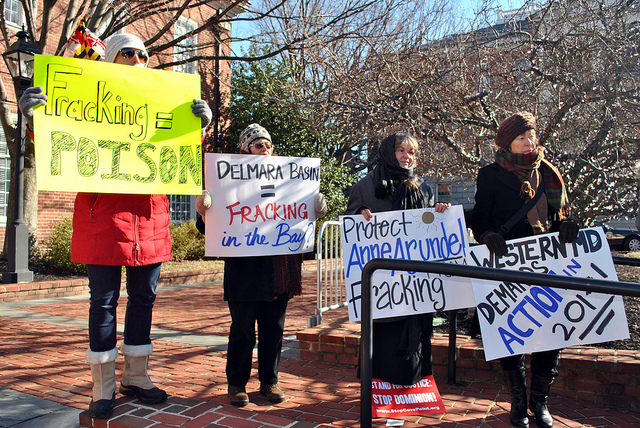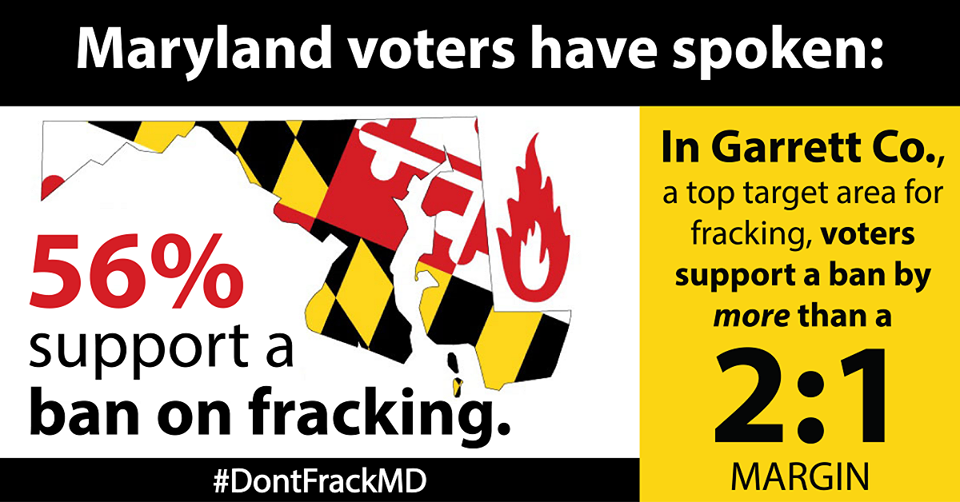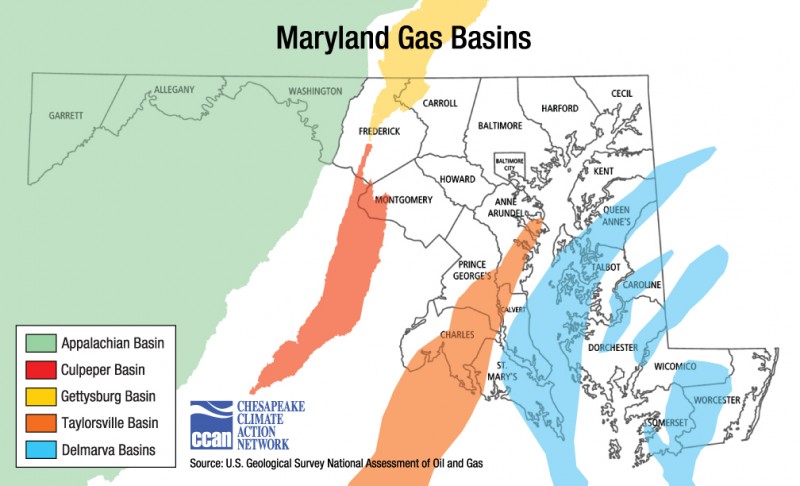
In March 2017, the Maryland General Assembly passed House Bill 1325, which will place a permanent ban on fracking in Maryland. The House of Delegates and the Senate both passed the bill with a bipartisan, veto-proof majority, sending it to be signed by Maryland Republican Governor Larry Hogan.
This move follows six years of organizing against the drilling practice from a grassroots movement that included farmers, doctors, students, faith leaders, environmental groups, and others. In the final year of the campaign 16 municipalities across the state passed bans, resolutions or statements of support in favor of a ban on this harmful drilling practice. During the legislative session over 600 grassroots activists lobbied in favor of a ban on hydraulic fracturing and over a 1000 people took to the streets in Annapolis for a march and rally. In the last days of the campaign, a group of 13 faith leaders and western Maryland residents were peacefully arrested in support of the fracking ban bill while it was being debated in the Senate, and one day later, Gov. Hogan reversed course to announce his support for a fracking ban.
Maryland will now become the first state in America with proven gas reserves to ban fracking by legislative action. It sets a nationally significant precedent as other states grapple with the dangerous drilling method. From Virginia (where leaders have imposed or proposed local bans at the county and municipal level) to the state of Florida (which is looking to follow Maryland’s statewide ban), the “keep-it-in-the-ground” movement is gaining new bipartisan steam. Read more here.
In neighboring states and across the nation, evidence is mounting that drilling and fracking for natural gas leads to polluted air and water, serious health problems, earthquakes and economic losses for local communities.
In Maryland, a growing grassroots movement has kept fracking at bay — for now. In the 2015 Maryland General Assembly, CCAN worked with over 70 groups in the Don’t Frack Maryland Coalition to put a 2.5 year moratorium on fracking. Thanks to thousands of email and calls, lobby, meetings, actions and more, Governor Larry Hogan let HB 449 become law on May 29th, 2015. This bill puts a hold on drilling in Maryland until October 2017.
But the gas industry began maneuvering to put fracking on the fast-track as soon as the moratorium would lift. There were over 100 groups working with the Don’t Frack Maryland Coalition to pass a ban on fracking in the 2017 General Assembly session. Our mission is to build an even more powerful grassroots movement to put a permanent, statewide ban on fracking by October 2017.
When the General Assembly came back in full-swing, our movement to ban fracking in Maryland moved at full-speed. The Maryland House of Delegates answered our movement’s call on March 10, 2017, when they passed House Bill 1325 to ban fracking with a bipartisan vote of 97-40. Just one week later in a historic move, Republican Governor Larry Hogan announced his support for a permanent statewide ban on fracking. Governor Hogan’s announcement came one day after 13 brave Marylanders were peacefully arrested outside of the State House to demand a ban on fracking. Soon after, the Senate finalized the ban on this risky drilling practice once and for all by putting Senate Bill 740 over the finish line.
Download the CCAN fracking activist toolkit: Get your city to endorse a ban on fracking.
Join the movement to ban fracking in Maryland: Email Brooke Harper at brooke@chesapeakeclimate.org to volunteer.
The Fracking Threat in Maryland
 The science shows that fracking threatens the air we breathe and the water we drink, while also worsening climate change.
The science shows that fracking threatens the air we breathe and the water we drink, while also worsening climate change.
Maryland’s Garrett and Allegany Counties sit atop the Marcellus Shale gas basin and are on the front lines of potential fracking in the state. But the threat is statewide. Across Maryland, five different gas basins stretch underneath our communities and could potentially be fracked by the gas industry. For instance, the Taylorsville gas basin stretches under one-third of Prince George’s County. A Texas-based company has already leased land to frack for gas in the Virginia portion of this same basin.
In 2011, Governor O’Malley issued a temporary, three-year executive order that put a hold on drilling permits in Maryland and created a commission to assess whether or not fracking poses unacceptable risks to Marylanders. The resulting studies warned of many significant risks — especially to our health — if fracking is allowed to proceed.
Marylanders Oppose Fracking

A long-term hold on drilling in Maryland is not only the right choice — it’s what the Maryland public wants.
- A 2016 OpinionWorks poll found that Maryland voters support a ban on fracking by a 2-to-1 margin.
- In Garrett County, a prime target area for the oil and gas industry, the margin of support is more than 2-to-1, with 57% in support of a fracking ban and only 27% opposed.
- The latest Washington Post poll found that a similarly strong majority of Marylanders — 60 percent — oppose fracking.
The Facts on Fracking
Fracking is a dangerous drilling method used to extract natural gas from shale rock. It involves drilling “L”-shaped pipelines deep underground and pumping a mixture of water, sand and toxic chemicals through them at high pressures to crack apart the rock and release gas packed within. (The chemicals used in fracking include benzene, xylene and toluene, all of which are known carcinogens.) Significant volumes of fracking fluid come back up to the surface loaded with heavy metals, toxic chemicals, and radioactive materials. This hazardous wastewater poses an enormous disposal challenge and the toxic chemicals in fracking fluid threaten to leach into our drinking water. The industrial well pads, machinery and truck traffic that come along with the drilling process disrupt rural towns, straining infrastructure, clogging roads, and adding to noise and air pollution.
 The evidence is mounting showing fracking is dangerous to our health. Especially concerning, researchers are finding associations between proximity to oil and gas development and increases in birth defects and other adverse birth outcomes. Because some effects may take years to show up, the nature and the severity of the long-term, cumulative health impacts of fracking and drilling are still unknown.
The evidence is mounting showing fracking is dangerous to our health. Especially concerning, researchers are finding associations between proximity to oil and gas development and increases in birth defects and other adverse birth outcomes. Because some effects may take years to show up, the nature and the severity of the long-term, cumulative health impacts of fracking and drilling are still unknown.
Fracking is a statewide threat in Maryland. The Marcellus Shale is probably the best known gas basin in the nation. It’s an enormous underground rock formation that spans areas from New York to Virginia, including Maryland’s Garrett and Allegany counties. But that’s not all: Maryland sits atop not one, but five gas basins that the natural gas industry could frack.
Learn about the Movement to ban fracking in Maryland!
Over 100 groups (and counting) in Maryland joined the “Don’t Frack Maryland” coalition– from climate groups like CCAN, to river keepers, outfitters, service unions, public interest organizations, health groups, farmers and faith groups.
And local opposition to fracking was widespread across Maryland:
- Montgomery County and Prince George’s County, which together represent over a third of Maryland’s population, have effectively banned fracking.
- The Frostburg City Council, which represents the largest municipality in western Maryland, voted unanimously to approve two measures designed to protect local water supplies from the toxic drilling practice, including a ban in city-owned property in Garrett County.
- The Garrett County towns of Friendsville and Mountain Lake Park also banned fracking.
- Councilmembers in Anne Arundel and Frederick Counties have called for a statewide ban
- The Baltimore County Council passed a resolution urging a statewide ban on fracking.
Resources
- Read the full language of the House and Senate bills to ban fracking: House Bill 1325 // Senate Bill 740, February 2017
- CCAN Statewide Fracking Ban Factsheet, CCAN
- The Risks to Maryland, CCAN, February 2014
- Fact sheet: U.S. Methane Leakage from Natural Gas Systems: Academic Literature from 2014 and 2015.
- OpinionWorks poll and infographic: 68 percent of Marylanders want the General Assembly to put a hold on fracking.
- The Risks to Maryland: Read the summary of an independent analysis showing fracking poses high risks to Maryland.
- Read the full Shale Gas Risk Assessment for Maryland (PDF).
- Map of Maryland’s Gas Basins
- Learn more about methane from the U.S. Environmental Protection Agency.
Key Articles
- “Maryland just passed a fracking ban. I’m weeping,” CCAN blog, 3/28/17
- “Governor [Hogan] calls for ban on fracking in Maryland, The Washington Post, 3/17/17.
- “Anti-fracking activists arrested for blocking entrance to Md. State House,” The Washington Post, 3/16/17.
- “Maryland House overwhelmingly approves bill to ban fracking,” ThinkProgress, 3/10/17
- “Activists push for ban on fracking in Maryland,” The Baltimore Sun, 3/2/17.
- “As Maryland lawmakers consider fracking rules, advocates ready to fight for permanent ban,” The Baltimore Sun, 12/20/16.
- “As MD’s Fracking Moratorium Expires, Lawmakers Plan a Ban,” WYPR. 11/8/16.
- “The EPA Once Said Fracking Did Not Cause Widespread Water Contamination. Not Anymore,” InsideClimate News, 12/14/16
- “Thank you Prince George’s County for banning fracking! The movement against fracking in Maryland is growing,” CCAN Blog. 4/12/2016.
- “Unconventional Natural Gas Development and Birth Outcomes in Pennsylvania, USA,” Wolters Kluwer Health, 9/30/2015.
- “Compendium of Scientific, Medical, and Media Findings Demonstrating Risks and Harms of Fracking,” Physicians for Social Responsibility, 10/14/2015.

